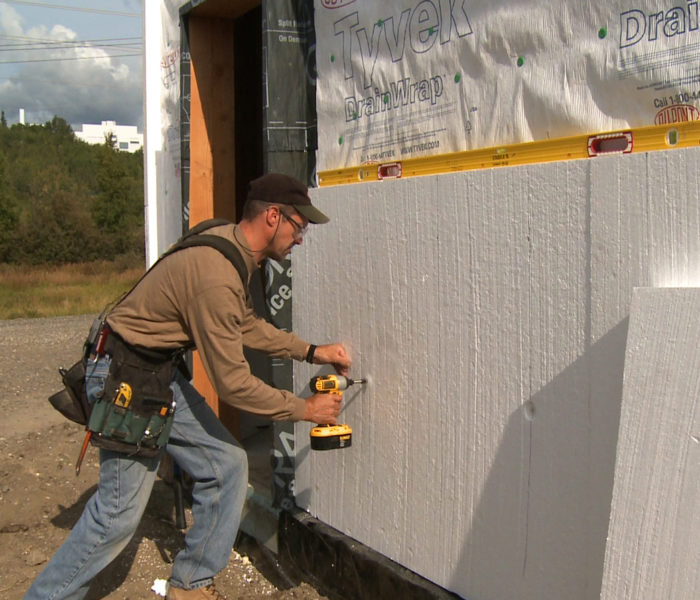
Jeremiah Sommer has been a builder in Ontario for nearly 30 years and has always used either OSB or plywood sheathing. Maybe it’s time for a change.
“Over the last couple years, my company has been moving in the direction of high-performance and Passive [House] building, which has led us down the path of superinsulated walls and all of the good stuff that comes with this method of construction,” Sommer writes in this recent Q&A post.
Sommer recognizes that plenty of builders have skipped conventional sheathing and opted instead for rigid foam over a braced stud wall. But their decisions seem to be mostly about saving money, and not for any reasons related to building science. Now, with newer building materials on the market, does this sheathing-free approach have some performance advantages?
“With the advent of products like Solitex Mento Plus from Pro Clima, which can be used directly over the exterior of a stud wall to create a sheathing-free enclosure and is robust enough to accommodate dense-pack cellulose or fiberglass, is ‘cold sheathing’ still a concern for thick double-stud walls?” he asks.
“To me the idea of installing a skin like this on the exterior with a vented rainscreen and using a smart vapor retarder on the interior of a dense-packed double-stud wall would create a very dry-able wall,” Sommer continues. “I realize that OSB or plywood might be necessary at times as a structural requirement but in situations when let-in wind bracing is suitable a sheathing-free wall seems to make sense. Also, it would be nice and light to stand. “
That’s where this Q&A Spotlight begins.
Consider these disadvantages
Kyle Bentley suggests that Sommer consider some of the consequences of walls without sheathing, including increased fire risk from using foam on the exterior,…
Weekly Newsletter
Get building science and energy efficiency advice, plus special offers, in your inbox.

This article is only available to GBA Prime Members
Sign up for a free trial and get instant access to this article as well as GBA’s complete library of premium articles and construction details.
Start Free TrialAlready a member? Log in















6 Comments
"Without sheathing, the siding would be the main “critter barrier,” he adds, and that would require a lot of detailing to be effective."
What kind of hoo ha is this? Every wall on hundreds of homes we fix have huge holes right through the OSB where rot occured (or didn't) and the mice had their way with all the fiberglass batting inside. No excuse for useless OSB and all the poor building practices around using it.
In terms of racking strength, that depends to some degree on the type of building and siding. post frame buildings that have steel siding rely to a degree on the posts and steel siding for racking strength. T-111 siding provides racking strength, especially when nailing patterns are designed that way (though using a rain screen design may reduce racking strength somewhat). Even sheets of 4x8 hardie-board siding if nailed sufficiently adds racking strength.
I'm old school and a big believer in sheathing, and preferably cdx plywood over OSB. First reason is structural integrity...Way back, I remember a b&w photo of a motel literally acting as a bridge due to the plywood sheathing after an earthquake opened a gap beneath it....Second is attachment of siding. If you're using horizontal siding with a rain screen, you need vertical furring strips....what are they nailed to if no sheathing. If you're using shingles (which are de rigueur in much of New England), you need that nail base. Note: and for those of you wondering why would anyone use cedar shingles when there are lots of other choices?..... probably most of all is that's what blends into the neighborhood and is traditional, but also because they provide a 50 plus year life with essentially zero maintenance, provide vapor permeability, etc. etc.
I'm only partially old school. When I helped in AK, Thorsten had the interior wall as load bearing and that had the sheathing. Gussets held on the exterior wall which had the membrane. As we had moisture readings, it proved the cellulose was never harmed and certainly not the interior warm plywood sheathing. Sud walls inside could be left empty.
I love the idea if reducing wood use but my biggest concern with wraps like Tyvec over air sealed plywood is longevity. All plastics break down over time or become brittle. Dry plywood is forever. Do I want to build a house where the air barrier may fail down the road?
This is the standard way to build in Australia. Passive builders have found it challenging to wrap the buildings that are a standard stick frame, but some seem to manage to get below 0.6ach using this method. Pro clima have marketed heavily to this sector of the building industry, but some say that their mechanical fixing method, especially for intello make it more challenging to create no air gaps. You can see some examples of this method on this distributors instagram page https://www.instagram.com/phcpvic/.
Personally I am about to build with SIPs and part of the reason for this was to help to reduce air infiltration. I am looking to use the Proctor Wraptite "peel and stick' vapour permeable membrane to seal it up tight, but also have a nice level of vapour permeance.
Log in or become a member to post a comment.
Sign up Log in